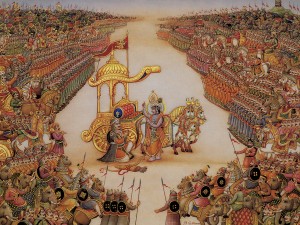February 27:
“I do not believe that the Gita teaches violence for doing good. It is pre-eminently a description of the duel that goes on in our own hearts.”
–Gandhi (Harijan, 8-24-1934, pp. 392-393)
(The battlefield, Krishna and Arjuna in the Gita…)
Many people wonder how someone who was committed to nonviolence like Gandhi could also find such sustenance– “a mother’s milk” he called it–in the Bhagavad Gita. The story, after all, is about a war, and the warrior, Arjuna, is exhorted to go back and fight, and chooses to do so.
In all religious traditions there are scriptures that convey their message in the form of allegory; and in all those traditions there is a danger that they will be taken literally. Such was the dilemma faced by the author of the Gita (Sri Krishna himself, on one level?) who used the allegory of battle for the inner struggle — called jihad in Islam — every one of us must undertake to realize our full potential. Will we attempt to conquer ourselves or continue to point the finger at others? Conquering others leads to more violence, while conquering ourselves is the first requirement — and the final benefit — in nonviolence.
Experiment in Nonviolence:
Read Chapter Three of the Bhagavad Gita, translated by Eknath Easwaran.
 Daily Metta 2015, a service of the Metta Center for Nonviolence, is a daily reflection on the strategic and spiritual insights of Mahatma Gandhi in thought, word and deed. As Gandhi called his life an “experiment in truth,” we have included an experiment in nonviolence to accompany each Daily Metta. Check in every day for new inspiration. Each year will be dedicated to another wisdom teacher.
Daily Metta 2015, a service of the Metta Center for Nonviolence, is a daily reflection on the strategic and spiritual insights of Mahatma Gandhi in thought, word and deed. As Gandhi called his life an “experiment in truth,” we have included an experiment in nonviolence to accompany each Daily Metta. Check in every day for new inspiration. Each year will be dedicated to another wisdom teacher.










So I was supposed to sympathize with Arjuna. Now that is good to know. We literal people do not get allegories.
🙂